#high castle abbey
Explore tagged Tumblr posts
Text
The Gothic in Classical Music History (1760s-1920s)
Intro Back in high school I fell in love with two things; classical music, and Edgar Allan Poe. I’ve always loved Halloween, October, spooky things, ghost stories, horror and slasher movies, etc. And I always loved finding classical music that was also spooky, or dark, or evocative of the same eerie experience of a cold and foggy October day. Thinking about these memories made me want to put together a short list of Gothic Classical music.
But what do I mean? There is no true “Gothic music” as in a specific movement in classical history, because the traditional Gothic refers to literature. Not all art movements have corresponding trends in all mediums. Even so I thought it would be fun to say, if there was such a thing as Gothic music, what would that include?
18th Century

John Henry Fuseli - The Nightmare (1781)
Music of the 1760s-1790s, corresponding with the first wave of “Gothic Novels” in the English language. Some names in this era include Horace Walpole (The Castle of Otranto), Ann Radcliffe (The Mysteries of Udolpho, The Italian) and Charles Brockden Brown (Wieland). The closest we have to music of this same era would be in the Sturm und Drang style. Sturm und Drang (Storm and Stress) was used to describe music written in a minor key that was restless, agitated, intense, emotional, and more extreme than the typical expectations for restraint and lightness/clarity, music that aristocrats in powdered wigs and velvet and lace could relax with. Strong changes of emotion and more emphasis on subjectivity, reflected by sudden modulations and pulsing rhythms.
The most famous piece that I associate with Sturm und Drang is Wolfgang Amadeus Mozart’s “little” g minor Symphony no.25, K.183 (1773). It is famously used in the opening of Miloš Forman’s Amadeus (1984). It is a fun piece, and that opening movement is full of fire, and probably the young Mozart having fun (he wrote it at 17. If you ever want to lower your self esteem, look up what music Mozart wrote at your current age.). Another major work would be Joseph Haydn’s “Farewell” Symphony no.45 (1772), written in the very unusual for the time key of f# minor. And of course, even though he comes later, anything Ludwig van Beethoven published in a minor key has a lot of muscular passion to it, and his early/classical era of the 1790s is no joke. Check out the final movements of his Piano Trio no.3 in c minor and his Piano Sonata no.1 in f minor, or his most famous early sonata, the Pathetique.
But if the Sturm und Drang style and Gothic genre also emphasize the disturbed and the psychological, we can include programmatic works that do the same. Mozart’s opera Don Giovanni (1788) has an incredible moment in the finale. The sociopathic hedonist is confronted by the ghost of the man he murdered in the first act, who possesses a statue and confronts Don Giovanni with his sins. Don Giovanni doesn’t repent, so he is dragged into hell with a chorus of demons. Always a good reminder that Mozart wasn’t the eternal child who wrote pretty melodies.
19th Century

Caspar David Friedrich - The Abbey in the Oakwood (1810)
Music of the early 19th century corresponds better with Gothic fiction because Romanticism in art brought greater interest in the supernatural, in the subjective, in emotional reactions to the universe… major names in fiction include the poetry of Lord Byron (Darkness), Mary Shelley (Frankenstein, The Last Man), and Sir Walter Scott (The Bride of Lammermoor). Greater emphasis is put on the anxiety of the unknown, supernatural fears beyond our control.
Of all Franz Schubert’s songs, Erlkönig (1815) best exemplifies the Gothic (and this is a bold claim because I only know about a fraction of Schubert’s extensive song output). In it, a father and son are riding on horseback. The son is sick with fever. As they ride, the son cries out that he can hear the Elf King calling out to him, some evil spirit or demon that wants to take the son’s life. The father tries to calm him down, but the Elf King gets closer and closer. By the time they reach home, the son has died. Was the Elf King real? Was the son hallucinating from fever? How literal should we take this text? The ambiguity of subjective experiences and how we interpret and understand reality is a major theme in Gothic fiction.
Many famous German operas lean into the supernatural and magical. In this period we get Carl Maria von Weber’s Der Freischütz (1821), considered to be the first Romantic opera. In it, our main character Max who needs to win a shooting contest so he can be allowed to marry his lover, Agathe. He is given a gun that can shoot magic bullets by another forrester Kaspar (who has his own plans). Kaspar tells Max to meet him in the “Wolf’s Glenn” in the woods at midnight for more magic bullets. In the Wolf’s Glenn, Kaspar calls for a spirit, the Black Huntsman Samiel, to help him curse the other characters, offering Max’s soul in exchange. Making deals with demons/the devil was another fascination in Romanticism.
Legends of a diabolical nature were springing around great musicians. At the end of the 1700s, Giuseppe Tartini wrote his most famous composition, the “Devil’s Trill” Violin Sonata in g minor which is full of virtuosic passages. Tartini claimed that the Devil appeared to him in a dream, and that he sold his soul in exchange for the Devil to be his servant. He handed the Devil his violin, and the Devil “…played with such great art and intelligence, as I had never even conceived in my boldest flights of fantasy. I felt enraptured, transported, enchanted: my breath failed me, and I awoke” Source
Similar stories came about with violinist Niccolò Paganini, who astonished the audiences of the early 19th century with his (for the time) otherworldly technique, dazzling them with scales and leaps and scratches the likes of which you can hear across his 24 Caprices for solo violin. A young Franz Liszt was at one of Paganini’s concerts and he was enthralled and inspired to become the “Paganini of the Piano”. He too would dazzle audiences with his percussive intensity, glittering arpeggios, and dreamy modulations to possess women with the spirits of hysteria and other dated misogynistic diseases. Cliche to say but before Bieber Fever, before Beatlemania, there was Lisztomania.
The sense of Faustian bargains comes through in the pieces Liszt wrote after Goethe’s Faust. The Faust Symphony (1857) includes a movement for Mephistopheles, the demon/ the Devil that bargains with Faust. The Mephistopheles movement has no original theme, but takes and corrupts the themes of Faust and his lover Gretchen into a mocking tone. Later on, Liszt was inspired to write a tone poem “The Dance in the Village Inn” or Mephisto Waltz no.1 (c.1862). He also wrote it for piano around the same time. The story has Mephistopheles taking Faust to a wedding in a village and playing the violin so madly, the partygoers are intoxicated by the music and go off dancing in the woods. Emotions taking over and making one act irrationally was another fascination in Gothic fiction.
Liszt would go on in his later years writing a few more Mephisto waltzes, with a lot of forward thinking harmonies and piano writing, unfortunately not as popular. Mephisto waltz no.2 (1881) has moments that make me think of Debussy, and the third (1883) has glittering and ethereal moments. But the best example of Liszt’s interest in the Gothic would be his earlier concert piece Totentanz (1949), or Dance of Death (Danse macabre). In it, the piano and orchestra play out variations on the Medieval chant Dies Irae, always reminding us of the inevitability of death. The variations depict skeletons dancing wildly all while the Mephistopheles at the piano unleashes his seductive tones.
The Dies Irae chant goes across our pop culture, with one famous iteration being a synthesized version of passages from Hector Berlioz’s Symphonie fantastique that Wendy Carlos wrote for Stanley Kubrick’s The Shining (1980) after Stephen King’s novel of the same name. And it was Berlioz’s symphony that enchanted audiences in 1830 with new, titanic sounds beyond what orchestra music had been before. In the story of the Symphonie fantastique, an artist has tried to overdose on opium after feeling rejected by unrequited love, but instead he has a vivid drug induced nightmare where he is sentenced to be beheaded via guillotine, which was still a traumatic living memory for the Parisian audience. He then sees himself among ghosts and monsters during a witches’ sabbath, the lovely woman’s beautiful theme is distorted into a grotesque mockery, the Dies Irae comes back among the cackling. It was a new degree of imagination expected from the audience. Later, Berlioz would depict demons in Pandæmonium (the Capital of Hell in Dante’s Inferno) at the end of his Damnation of Faust.
Through the mid to late 19th century we get authors of Gothic literature such as Edgar Allan Poe, Elizabeth Gaskell, Emily and Charlotte Brontë, Nathaniel Hawethorne, and Victor Hugo. We also get two more operas that have Gothic themes. First is Richard Wagner’s The Flying Dutchman (1843). In this opera, a ship on the North Sea collides with the Ghost Ship of the Flying Dutchman who is cursed to sail the seas forever, but is allowed to come ashore once every seven years and if he can find a wife, he will be freed. I’m sure you can guess how this opera ends. The overture is often played in concert for a condensed version of Wagnarian thunder and romance. The next important opera is Giuseppe Verdi’s Macbeth (1847), because Shakespeare was being revived and translated in different languages across Europe and Verdi loved his plays. In the opera, Macbeth comes across a chorus of witches that foretell his success and downfall. He is too ambitious and goaded by Lady Macbeth, plans to take the throne through deception and murder. Lady Macbeth is later haunted with phantom blood on her hands which only she can see. And Macbeth succumbs to his inevitable fate.
We also get two significantly “Gothic” pieces of orchestra music. They are both tone poems, which also reflects the concert goers’ tastes. The one that has always been a quintessential “Halloween classical” piece is Camille Saint-Saens’ Danse Macabre (1875), opening at the stroke of midnight (softly evoked by the harp), a violin shrieks out the tritone (the “Devil’s interval” which the Romantics thought meant was cursed by the superstitious Medievals, really it was an idiom for “hard to use in music”) and introduces ballroom music along with the clacking bones of skeletons dancing in the graveyard (evoked by the xylophone). The skeletons dance through the night until the rooster crows at dawn.
The other great Halloween concert piece is Modest Mussorgsky’s Night on Bald Mountain (1867) which depicts another witches sabbath, this time on St. John’s Night, a major holiday in Slavic Eastern Orthodox culture. Walt Disney’s Fantasia (1940) would help bring this poem to life with an animated phantasmagoria of ghouls and skeletal horses and other demons flying around the mountainous demon Chernoberg.
[Here I want to give a quick shoutout to Cesar Franck’s Le Chasseur maudit (The Accursed Huntsman), a tone poem about a Count who doesn’t go to church one Sunday, and instead rides around to whip peasants for his own amusement, so demons drag him to hell. Not nearly as famous a concert piece as the others mentioned in this list but it has colorful orchestration so you should check it out.]
The initial idea for Fantasia was for Disney to repopularize Mickey Mouse by writing him into an animated version of Paul Dukas’ The Sorcerer’s Apprentice. The original poem by Goethe was a classic that Paul Dukas set to music in 1897. In it, we hear the Sorcerer leave his Apprentice to clean the floors of his workshop. The Apprentice uses magic to bring a broom to life so it can do the chores for him. The Broom mindlessly pours buckets of water all over the floor, and the Apprentice isn’t good enough with magic to stop it. He chops it up into pieces with an ax, but they regenerate into several brooms which go back to marching water in. The Sorcerer returns to clean the mess and scolds his Apprentice. This charming tale has a darker and more diabolically fun tone in Dukas orchestra.
20th Century
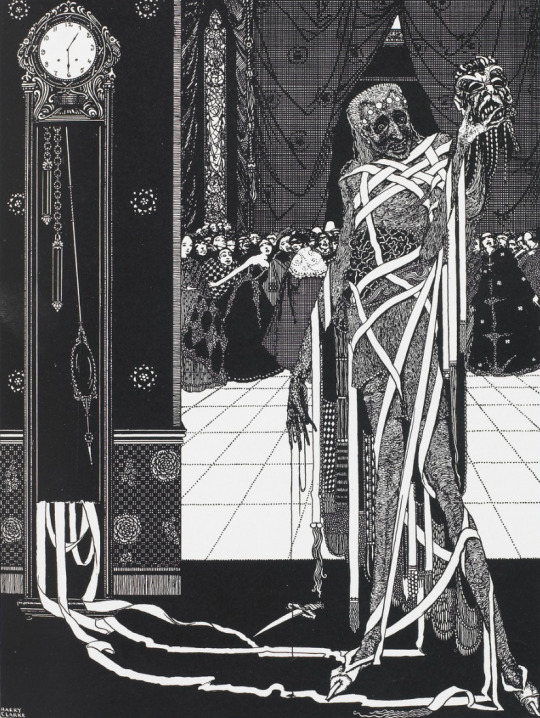
Harry Clarke - Illustration for "Masque of the Red Death" (1919)
In the same exact year of Dukas’ tone poem, we get Bram Stoker’s Dracula. At this turn of the century other major names include Gaston Luroux (The Phantom of the Opera), Robert Lewis Stevenson (Dr. Jekyll and Mr. Hyde), Henry James (The Turn of the Screw), Oscar Wilde (The Picture of Dorian Gray). At this time, there are a few more pieces that continue trying to evoke Gothic subject matter. One comes from Gustav Mahler’s Symphony no.7 (1905), sometimes dubbed “Song of the Night”. Two of the symphonies five movements are titled “Nachtmusik” (night music), the first is more in line with Gothic anxiety and spookiness than the second which is more like a serenade. But the most Gothic movement is the Scherzo which sits in the middle of the symphony and is like a Viennese ballroom full of dancing corpses and skeletons as waltz music decays with them.
A surprising example (at least, because of how relatively obscure it is) comes from Claude Debussy with parts of an opera based on Poe’s The Fall of the House of Usher that he worked on between 1908-1917. Not too much a surprise on the one hand because French translations of Poe’s work became popular and influential. On the other hand Debussy is more known for evocative sound pictures, unique musical colors, and subtlety. Perhaps he was drawn to symbolist and psychosexual interpretations of The House of Usher, the same interests that preoccupied him with his only finished opera Pelleas et Melisande. Roger Orledge reconstructed the opera and tried to stay true to Debussy’s style, so what we do have is passable and as shadowy and vague as his other orchestral masterpieces.
Maybe the hardest work to recommend (but I do recommend regardless, give it a chance) is a Modernist song cycle for chamber ensemble. Arnold Schoenberg’s Pierrot Lunaire (1910) uses freely chromatic atonality to give a demented color of psychosis experienced by Pierrot, personified version of a stock character for old Commedia dell Arte plays, a clown who over time became the “sad clown”. Maybe a precursor to the demon from Stephen King’s It, or the demented clowns and jesters that laugh at the madness of the cosmos across Thomas Ligotti’s short stories.
This was only meant to be a small overview of works that could fit my own view of the Gothic in music. There are more examples I could include, so as a hint toward today, I’ll end with a piece that was written about a century ago, yet sounds as if it could have been written today. Henry Cowell’s The Banshee (1925) is a short piano piece, so if you can, at least listen to this one. Instead of playing with the keys like you’re “supposed to”, Cowell asks the performer to drag their fingers along the wires directly. This creates disturbing reverberations and scratching sounds that tingle the back of your neck, that feel like the otherworldly cry of a Banshee.
Happy Halloween.
#classical music#Halloween classical#Halloween#Halloween music#Mozart#Haydn#Beethoven#Schubert#Liszt#Paganini#Berlioz#Saint-Saens#Mussorgsky#Wagner#Verdi#Dukas#Mahler#Debussy#Schoenberg#Cowell#Wolfgang Amadeus Mozart#Josef Haydn#Ludwig van Beethoven#Franz Schubert#Niccolo Paganini#Franz Liszt#Hector Berlioz#Camille Saint-Saens#Cesar Franck#Franck
73 notes
·
View notes
Text
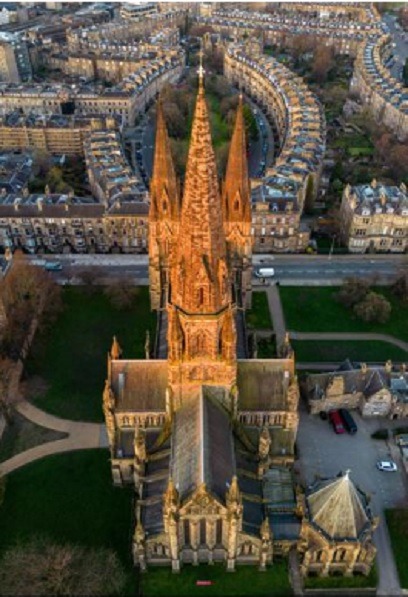

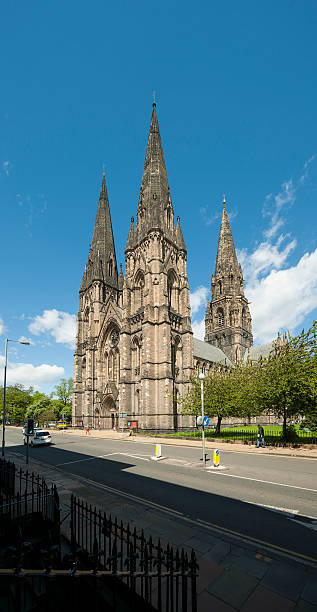

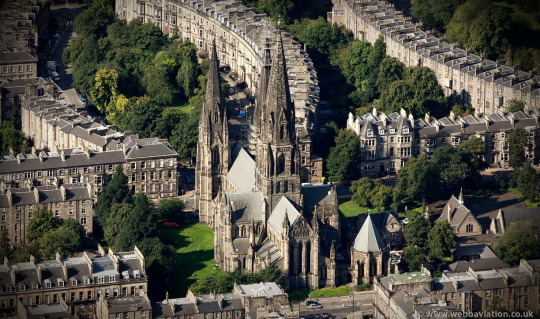


On October 29th 1879 a service of consecration was held at the newly completed St Mary’s Episcopal Cathedral in Edinburgh.
At the “glorious” revolution in 1688, the Scottish bishops and supporting clergy were ejected as non-Jurors because they refused to swear an oath to William of Orange, choosing instead to support the supplanted King James; so the established church in Scotland was handed over to Presbyterian governance. St Giles in consequence became once more the “High Kirk” of Edinburgh. The ejected Episcopalians, because of their Jacobite leanings, became subject to severe penal laws until 1792. After this they were free, largely to develop as they could. Gradually their obscure meeting houses gave place to churches, but for many poverty-stricken years there were no cathedrals in the seven dioceses of Scotland. In particular, in the Diocese of Edinburgh other churches were used as the “pro-Cathedral” until St Mary’s was completed in 1879, it took five years to build.
Barbara and Mary Walker left the whole of their property to the Episcopal Church in Scotland, thus enabling the building of a Cathedral which was to be dedicated to St Mary the Virgin, and also setting up trustees to endow the Cathedral and to set up grants in aid of other church work.
An architectural competition was arranged. Amid controversy, including accusations of plagiarism and favouritism from six competing designs, three from Scottish, three from English architects. That of the English Sir George Gilbert Scott was chosen with plans submitted under the clever anonymous motto, “Auld Lang Syne”. The foundation stone was laid on 21st May 1874 by the Duke of Buccleuch and Queensberry, and the building consecrated on 30th October 1879. The cost was £110,000, but rising wages forbad the completion of the Chapter House and western spires. The former was added in 1890 at a cost of £5,000, the latter by church people in memory of the founders during 1913-17 at a cost of £13,200.
The style of Scott’s design for the Cathedral was inspired by the early Gothic churches and abbeys of Scotland. He gave it as large a floor space as the site would allow and made the massive central tower and spire and the twin western spires such prominent features that they may be seen from miles away. The enormous weight of the central tower is carried on four main pillars and spread through diagonal arches into buttresses in the outer walls, leaving unusually open views inside.
Whereas you can see the spires of St Mary’s from any elevated position in Edinburgh, the close confines of the New Town means it is hardly visible from surrounding streets, except the wide vistas of Melville street, which is a shame, I think it is not visited as much as other City attractions, it is well worth a visit, and if you are after an early start on a tour of Edinburgh the Cathedral opens its doors at 7.30 each morning, it can be eerily quiet at that time and I would say is the best chance to grab pics without other tourists around getting in your shots. If you have a good camera with plenty of zoom, you can get a good pic of the spires from Edinburgh Castle, as seen from the last pic.
My highlight inside is the modern stained-glass windows by Eduardo Paolozzi, “inventor” of the Pop art movement.
65 notes
·
View notes
Text
STATE VISIT BY THE EMPEROR AND EMPRESS OF JAPAN Tuesday 25th - Thursday 27th June 2024
Their Majesties The Emperor and Empress of Japan will pay a State Visit to the United Kingdom as guests of His Majesty The King from Tuesday 25th to Thursday 27th June 2024.
Their Majesties The King and Queen will host the State Visit at Buckingham Palace.
STATE VISIT PROGRAMME:
SATURDAY 22nd JUNE • The Emperor and Empress of Japan will arrive privately in the United Kingdom on the afternoon of Saturday 22nd June at Stansted Airport. • Their Majesties will be greeted by His Excellency Mr Hajime Hayashi, Ambassador of Japan. The Viscount Brookeborough KG, Lord-in-Waiting, will greet Their Majesties on behalf of The King.
SUNDAY 23rd JUNE AND MONDAY 24TH JUNE • Before the State Visit formally commences, the Emperor will conduct a private programme of engagements, including a visit to Japan House and the Thames Barrier.
TUESDAY 25th JUNE • His Royal Highness The Prince of Wales will greet the Emperor and Empress of Japan, at their hotel, on behalf of The King on Tuesday morning. • His Royal Highness will travel with the Emperor and Empress to Horse Guards Parade, where Their Majesties will receive a Ceremonial Welcome. • The King and Queen will formally welcome the Emperor and Empress at the Royal Pavilion on Horse Guards Parade. Presentations will be made, the Guard of Honour will give a Royal Salute and the Japanese National Anthem will be played. • The King and Queen will formally welcome the Emperor and Empress at the Royal Pavilion on Horse Guards Parade. Presentations will be made, the Guard of Honour will give a Royal Salute and the Japanese National Anthem will be played. • The Emperor, accompanied by The King, will then inspect the Guard of Honour, formed of the 1st Battalion Welsh Guards with the Band of the Welsh Guards. Afterwards, the Emperor and Empress will join The King and Queen, and The Prince of Wales, in a carriage procession along The Mall to Buckingham Palace, where they will be met by a second Guard of Honour formed of the 1st Battalion Welsh Guards. • Following a lunch at Buckingham Palace, given by The King, His Majesty will invite the Emperor and Empress to view a special exhibition in the Picture Gallery of items from the Royal Collection relating to Japan. • In the afternoon, the Emperor and Empress will visit Westminster Abbey, where the Emperor will lay a wreath at the Grave of the Unknown Warrior. Their Majesties will take a tour of the Abbey, accompanied by the Dean of Westminster. • In the evening, The King, accompanied by The Queen and Members of the Royal Family, will give a State Banquet at Buckingham Palace for The Emperor and Empress of Japan. Speeches will be made by The King and the Emperor at the beginning of the banquet.
WEDNESDAY 26th JUNE • The Emperor will visit The Francis Crick Institute, the UK's flagship biomedical research centre. The Institute supports an innovative UK-Japan research partnership which covers a range of public health issues, including cancer, vaccines, and the role of genetics in infectious diseases. • That evening, The Emperor of Japan, joined by Their Royal Highnesses The Duke and Duchess of Edinburgh, will attend a Banquet at the Guildhall given by the Lord Mayor and City of London Corporation. The Lord Mayor and The Emperor will both make speeches at the end of the banquet.
THURSDAY 27th JUNE • The Emperor and Empress of Japan will formally bid farewell to The King and Queen at Buckingham Palace on the morning of the final day of the official State Visit programme. • The Emperor and Empress will travel to Young V&A, part of the V&A family of museums dedicated to the power of creativity around the world, where the museum's Japan: Myths to Manga exhibition is currently on display. • The Emperor will privately visit St. George's Chapel, Windsor Castle, to lay a wreath on the tomb of Queen Elizabeth II, in the King George VI Chapel. The Garter Banners of the current members of the Order of the Garter, including the banner belonging to • His Majesty's father, Emperor Emeritus Akihito, are displayed in the Quire of St. George's Chapel. • Later that afternoon, His Majesty the Emperor will tour the historic Temperate House at the Royal Botanic Gardens, Kew. The Millennium Seed Bank, coordinated by Kew is the world's largest collection of over 2.4 billion wild plant seeds spanning 97 countries, preserving Japanese and international biodiversity. Bronze Bonsai sculptures by artist Marc Quinn are currently displayed in the Temperate House, surrounded by a display of Bonsai trees from Kew's collection.
FRIDAY 28th JUNE • On their final day in the UK, The Emperor and Empress of Japan will visit Oxford for a private programme of engagements including a visit to the colleges where Their Majesties studied. • At the conclusion of the visit, The Lord Chamberlain will bid farewell to the Emperor and Empress on behalf of The King, before they depart from RAF Brize Norton.
110 notes
·
View notes
Text
Angel of Small Death
Part 7 in my Halloween mini series!
Dark Priest!Billy Russo, Dark Priest!Matt Murdock, Dark!Frank Castle
Warnings: Major blasphemy, dub-con, corruption, spanking (with a Bible), very very inappropriate use of said Bible, oral (f), edging, being held in place.

You check on Billy in the morning.
He has no recollection of ever being in the attic, no clue how he got there or even why. The last thing he remembered was going to sleep the night before.
He looks so concerned, so worried, that you don't bother to tell him about the things he did, the things you wanted him to do.
Your heart hurts a little at the thought, that all of his words had no meaning, that those hungry, ravenous kisses weren't meant for you.
It helps you grow more complacent with the idea of Father Murdock's punishment, that your loyalties were to God, and this monastery, and a few moments of weakness couldn't define you.
Your head is held high when you step into Matt's office at midday, prepared for whatever punishment he would dole out.
You would take it, and you would grow from it.
But you stiffen when you step in to find a person you’re not expecting.
“Mister Castle?” You ask curiously, your stomach going queasy with anxiety.
Frank turns, lifting his head from the bible in his hands, looking at you in an expectant and eager way that has you second guessing the strength of your resolve.
“Hey sweetheart,” He murmurs, snapping the book shut, “you’re right on time.”
“On time?” You question, wondering exactly how much he knew. Glancing around the room you note that Matthew isn’t even here.
He gives you a cryptic smile, moving toward you, placing the bible onto Matthew’s desk, before stopping in front of you.
His face is contemplative, stern, he raises a hand, trailing the backs of his fingers over your cheek.
Your breath catches as his touch tingles across your skin.
“Billy keeps touching you when he knows he shouldn’t.” His voice ripples across your skin, that spot between your legs warms slightly.
You swallow, feeling the need to defend your longtime friend.
“He was just confused, he didn’t mean to.”
“No?” Frank asks, “And what about the night he came into your room to taste you? Was he confused then?”
Your eyebrows draw together.
Had that actually happened? Was it not a vivid dream? How did Frank know about it?
You can’t find the words to express your disbelief, searching his face for any indication that he was lying to you.
“That didn’t happen.” You protest weakly.
Instead of responding, his smile only deepens.
The sound of the door locking behind you draws your attention, and you turn to see Father Murdock standing at the door.
“I’m happy to see you came,” Matthew says, and you frown, opening your mouth to tell him that you hadn’t had much of a choice.
“Oh, I wouldn’t miss this.” Frank answers. You glance at him, your brain teetering on overdrive as you try to fit pieces together that don’t go quite right.
Matthew leans his cane against the door, carefully approaching the both of you.
“And you, little one, are you ready to accept your sins and work towards redemption?”
You straighten.
“I am.”
“Good.” he says with finality, approaching you.
He reaches out, fingers finding your rosary around your neck, tracing the pearls.
“Tell me about this.” He says.
You swallow, glancing down at the rosary in question.
“It’s been passed down through each Mother Superior for generations. I inherited it when she passed. God bless her soul.”
“I see, and how did she die?”
You blink, wondering how he hasn’t heard the bizarre story yet.
“She got sick, they all did, every senior person in the abbey. It was horrible.”
“You poor thing.” Frank says, stepping closer behind you, and you turn to look up at him.
You give him a weak smile.
“It happens, I guess. The Lord’s reasons are not always known to us.”
He chuckles, lifting a hand to hover it over your rosary as well, never actually touching it.
“I suppose so.” He murmurs.
“Remove it,” Matthew’s voice interjects, “We are going to begin your punishment now.”
You nod, shakily tugging the rosary over your head, wrapping it around your fist with the expectation that you’re going to pray.
“Bend over my desk.”
You freeze.
“Wh-what?”
Matthew angles his head, saying Frank’s name, your eyes dart between the men as some kind of silent exchange happens.
Frank smiles politely, reaching out to grip your shoulders.
“I don’t think he wants to repeat himself, sweetheart.” Frank says, turning your body and guiding you toward the wooden desk.
Your hips pressed flush to the desk, you gasp as he presses on your shoulder, bending you over the table.
When you try to protest, and raise your body, Frank reaches to grip your wrists, pressing them down.
It renders you somewhat immobile, Frank moves to sit in the chair right in front of you, almost at eye level, while he keeps his grip firm on your wrists.
“What is going on? What kind of punishment is this?” You ask, wriggling, confused as to how this will redeem you in any way.
You feel hands settle on your backside, tugging your skirt up slowly.
“This punishment,” Matthew says behind you, “Is designed to make you reflect on your sins, to associate any thoughts of defilement with discomfort.”
Frank’s grip tightens on your wrists, drawing your attention.
“Don’t panic,” He whispers, leaning in close to you so that his voice is right in your ear, “Just look at me, and it’ll be over before you know it.”
His eyes do calm you, the warmth of his hands and the smell of sage that fills your senses eases your nerves.
You let out a slow breath, nodding at Frank.
Your eyes widen dramatically in the next moment when you feel your undergarments tugged down the length of your legs.
Your lower half is exposed to Father Murdock, and you stiffen when you feel his bare hand grip at the flesh of your cheek firmly.
“Let’s start simple,” Matt starts, “Was that the first time you’ve let a man touch you?”
You swallow.
“No.”
Something firm comes down on your rear, it makes a dull sound before you feel a gentle sting.
You turn your head, catching sight of the Bible that Frank had been reading earlier in Father Murdock’s hands, but as soon as you see it, Frank’s free hand is on your jaw, twisting your vision back to him.
He shakes his head.
“Keep those pretty eyes on me.” He commands.
You shiver, nodding, mouth dropping open at the flood of sensations you were experiencing, that… wasn’t quite bad at all.
“When was the first time you let someone defile you?” Matthew asks.
Frank's eyes study your face as you contemplate your answer.
“I kissed Billy, i-in the gazebo in the cemetery, when I was around seventeen.”
You gasp, feeling another hit against your rear, your eyes rolling in pleasure for just a moment.
“Is that all?”
“N-no, I kissed him a few days ago, in the same place.”
The bible hits you again.
“He’s the only man you’ve ever kissed?”
“Yes.” You answer honestly.
“But he’s not the only man you desire.” Matthew continues with a statement, and not a question.
“Um,” You murmur, trying to stall.
The bible comes down harder on your flesh, and you can’t help the moan that leaves your mouth.
“Please, Father Murdock, I’m sorry.”
His palm presses to your heated rear, fingers dipping down until they brush against your most intimate parts.
“You don’t feel sorry, little one, you feel wet.”
A whine leaves your throat, his fingers probe you, gliding over your cunt, pausing on your aching bud.
“Is this what you want? Does it excite you to be touched like this?”
You don’t answer, dropping your head in shame.
Another spank, this time a little harder than you expect.
Tears pool in your eyes.
“Yes, Father.” You answer honestly.
Another hit, followed by another. The pain stings, your body hot, the little spot between your legs throbbing, begging for attention.
You feel his hand, pulling your legs further apart, before something rubs against your center.
You tip your head back, mouth open, but before any sound can get out, Frank is pushing his thumb into your mouth.
“Not too loud, we don’t want anyone to hear you.”
Tears slip from the outer corners of your eyes, down your cheeks to pool in his hand, Matthew rubs the spine of the bible between your thighs in a slow, agonising movement.
You moan around Frank’s thumb, eyes fluttering shut as pleasure you’ve never felt before assails you.
Frank’s rough thumb sways over your thumb, you whimper, opening your eyes to meet his.
Matthew continues to give you pleasure, instead of pain, rubbing the indented leather spine along the seam of your cunt, pressing in, circling against you for a few moments.
Your fingers curl around your rosary, an aching throb begging you to tilt your hips up and rock your body further onto Matthew’s bible.
He spanks you again, and your only response is to suck on Frank’s fingers more passionately.
You flutter your pleading eyes at him, trying for the first time, to seduce, to encourage him to pleasure your body.
Frank smiles, dark eyes that seem to bore right into your soul, he leans forward to delicately glide his nose against yours.
“You take punishment so beautifully, sweetheart.”
You lean into the palm of his hand, accepting the compliment gratefully.
Your head swarms with pleasure, approaching that peak so easily you can almost taste it, Matt behind you, quietly pleasuring you.
You groan in dismay when he stops, feeling his hands smooth over the curves of your behind.
Your face is so close to Frank’s that you don’t react when you feel his tongue dart out to lick your tears away. You’re surprised at the way it feels, very different from Billy’s rougher, longer, an oddness to it that you cannot put your finger on.
You accept your fate, at the mercy of these two men, wondering briefly how Billy would fit into the mix.
Frank pulls his thumb out of your mouth, gripping your jaw softly so that he can press his mouth to yours.
At the same time, you feel a tongue dart out to lick between your legs.
You feel like putty, being molded anew, as Frank kisses your lips and Matthew kisses your cunt.
You gasp into Frank’s mouth, feel him chuckle, his lips taste sweet, soft, his tongue- dextrous and wicked, delving into your mouth with expert precision.
Humming, you note hazily that Frank’s tongue has two points, the movements are vile, delicious, you want to feel like this permanently.
Matt’s tongue is no less capable, licking hungrily at your wetness, humming into your delicate skin, kissing the areas that he’s punished with his bible.
Your toes curl, fingers tight around your rosary, head floating. Your body trembles, your breath stalling in your chest as bliss approaches.
Matthew’s tongue withdraws, and you find that the disappointment is almost too much to bear.
You stiffen, eyes searching Frank’s, begging for something more as Matthew rights your underwear, pulling your skirt over your legs.
Frank withdraws too, you glance down, watching as he removes his hand from around your wrists, his palm holding odd marks where your rosary has touched him.
“Why?” You whisper helplessly.
“Punishments are not supposed to feel good, little one, they’re supposed to make you want to be good.”
Your body responds eagerly to Matthew’s words. You find that he’s right, you want to be good, you want- more of what he gave you.
“How do I be good?” You ask timidly.
Matthew helps you stand on shaky legs, his mouth- pink and glistening- no doubt with your arousal.
“Obedience.” He answers your question, carefully untangling your rosary from your hands and placing it around your neck.
He takes a second, running his thumb across your bottom lip gently, the gesture heavy with affection.
“I have to go now, but I'll see you later?” He murmurs.
You nod, looking up at him with glassy eyes, wondering if you were too much above begging for release.
You don't get a chance to contemplate it further, before he leaves.
You drop your head, contemplating your actions, before turning to look at Frank.
“I'm confused.”
Frank chuckles, moving around the table to stand before you.
“What's troubling you?”
“I was just punished for letting Billy almost defile me last night, and in the process, he- you both- well you defiled me in a way too.”
“That does sound confusing, yes.” He agrees, stepping in closer. You take a deep breath, enjoying his masculine scent.
“I think, sweetheart, you just have to accept that these things are barely going to make sense from now on.”
Your eyebrows draw together in further confusion. He reaches up, fingers stroking your jaw to bring your attention back to him.
“You really are beautiful.” He says, deep in thought. You feel heat rising to your cheeks.
“Th- thank you.” You whisper.
.
“When was the last time he was seen?” Sister April asks.
You wait, listening to Sister Margaret's mumbled response.
“Perhaps at morning mass yesterday? Definitely not after that. Father Murdock even confirmed that he wasn't in the dormitory last night.”
“It was pouring last night,” you recall, “Could he have gotten lost somewhere?”
Sister April lifts her shoulders.
“It’s possible, everyone is looking for him, hopefully he is found soon.”
You nod in agreement, concerned for one of the monks residing here.
You’d been so caught up with Billy, Matthew and Frank, that you’d let your duties to your people fall short, and now someone was missing.
It was hard not to blame yourself.
.
.
.
#billy russo#billy russo x reader#billy russo x female reader#my writings#the punisher#dark!billy russo#matt murdock#matt murdock smut#dark!matt murdock#dark!matt murdock x reader#dark!frank castle x reader#dark!frank castle
48 notes
·
View notes
Text
okay since I'm running a PG-13 Curse of Strahd game in which my players specifically asked for it to not be too scary, and this party of ex-burglars and thieves responded really well to their old boss being the one who sent them to Barovia, I'm gonna go full-speed ahead on a pretty big tone change
which is that instead of this campaign being a horror crawl
I'm gonna try to frame Curse of Strahd as a giant heist mission
THEIR MISSION (should they choose to accept it):
Steal three magic artifacts out from under the noses of Strahd's associates. The first is in a hidden safe in the Abbey, the second they'll have to sneak out past Baba Lysaga, and the third is in a high-security treasure vault deep in the Amber Temple.
Assemble a crew. They'll meet many people in Barovia but there are two fated companions who'll be of the most help: Pidlwick II has intimate knowledge of the layout of the castle. Ez has experience dealing with supernatural bullshit and can advise on how to get past all of Strahd's goons.
Case the joint. Somehow they need to get invited into Strahd's castle so that they can poke around, learn about his defenses, plan their entry and exit, and figure out how to best dismantle his entire operation from the inside without him catching wise to their plan.
Then, once the final plan is in place, they strike.
And then idk they kick his ass, take over his castle, take all his money, steal his carriage, and ride off into the sunset.
#the wild thing is that this won't actually be that big a change?#I'm not rewriting anything#I'm just adding one more companion#and changing the way that the campaign goals are framed#Strahd will be exactly the same#because HE doesn't know he's in a heist movie#queued post bc lazy#strahdposting#barovia#strahd von zarovich#curse of strahd#cos#strahd campaign#dnd strahd#dnd#dnd shenanigans#dnd campaign#dnd5e#d&d campaign#d&d 5e#d&d#dungeon master#dungeons and dragons#d&d heist#DND heist
35 notes
·
View notes
Text
Choose Your Magic School
So, a while back I developed a magic school divided into nine sub-schools; each sub-school is located on a mountaintop, collectively forming a circle of mountains, with a common space between them where students from all schools can meet.
The locations of the sub-schools are as follows:
Alchemists are located in a steampunk-style castle atop a mountain covered in birch woods, and they have an aviary of phoenixes.
Conjurers (think Ancient-Egyptian-style magic) are located in a giant pyramid atop a mountain covered in gardens like this, and they have a living sphinx who patrols the base.
Mystics are located in a wooden monastery atop a mountain covered in frozen waterfalls and snowy trees, and they have a yeti who hides in the forest.
Necromancers (who here can be good or evil) are located in catacombs amidst a mountain covered in mausoleums, gravestones etc. and willow and yew trees, and they have a pack of hellhounds who act as class pets.
Observers (UFO-based magic) are located in a giant observatory atop a mountain covered in dark pine woods, and they have a mothman who swoops around the trees.
Shamans are located in a treetop village atop a mountain covered in jungle, and they get up to and down from the villages by means of griffins.
Sorcerers (stereotypical evil magic, but can be good or evil) are located in a huge black tower atop a mountain covered in ash and dead trees, and they have a dragon in a cave on the mo.
Witches (rural magic) are located in a cute village of cottages atop a mountain covered in oak, beeches and streams, and they have a stable of unicorns.
Wizards (high-church-styled magic) are located in a Romanesque abbey complex atop a mountain covered in herb gardens, and they have apparitions of seraphim.
Tagging @roses-red-and-pink, @melisssg99, @cactusflowerfemme and @rebelnurse
36 notes
·
View notes
Text

Medieval Grave Slabs Recovered From Historic Shipwreck
Maritime archaeologists from Bournemouth University have recovered two medieval graves slabs which have been lying at the bottom of Studland Bay for nearly 800 years.
The slabs, carved from Purbeck marble, were amongst the cargo of England’s oldest historic shipwreck, which sank off the Dorset coast during the reign of Henry III in the thirteenth century.
The site has been named the “Mortar Wreck” because other items in its cargo included a large number of grinding mortars, also made from Purbeck stone. Details of the discovery will shortly be published in the journal Antiquity.
Divers and archaeologists led by BU brought the slabs to the surface on 4 June in a two hour operation from a depth of around seven metres where the stones lay.
One immaculately preserved slab measures one and a half metres and weighs an estimated 70 kilogrammes. The other, much larger slab is in two pieces, with a combined length of two metres and a weight of around 200 kilogrammes.
Both have carvings of Christian crosses which were popular in the thirteenth century and the research team believe they were intended to be coffin lids or crypt monuments for high status individuals in the clergy.



“The wreck went down in the height of the Purbeck stone industry and the grave slabs we have here were a very popular monument for bishops and archbishops across all the cathedrals and monasteries in England at the time,” explained Tom Cousins, a Maritime Archaeologist at Bournemouth University who led the recovery. “Examples have been found in Westminster Abbey, Canterbury Cathedral and Salisbury Cathedral, he added.”
The slabs will now be desalinated and conserved by the Bournemouth team until they can be put on public display along with the other recovered artefacts in the new Shipwreck Gallery when Poole Museum reopens next year.
The site of the Mortar Wreck was first discovered as an ‘obstruction’ in 1982 but was assumed to be a pile of rubble on the seabed. Its significance was not realised until 2019 when Tom and a team from the University dived the site on the suggestion of local charter skipper Trevor Small and uncovered the secrets lying under the sand.
The continued recovery of the artefacts, such as the mortars and grave slabs, will allow the Bournemouth team to learn more about thirteenth century life and the ancient craft of stonemasonry.
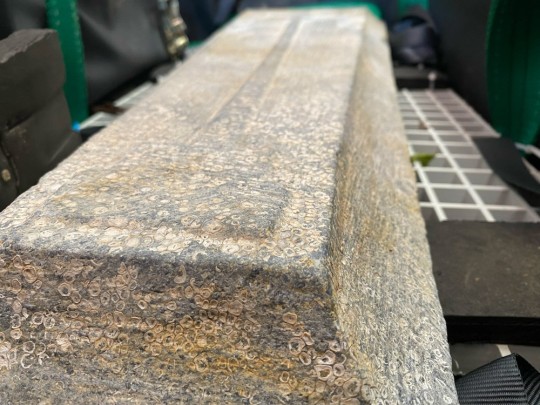
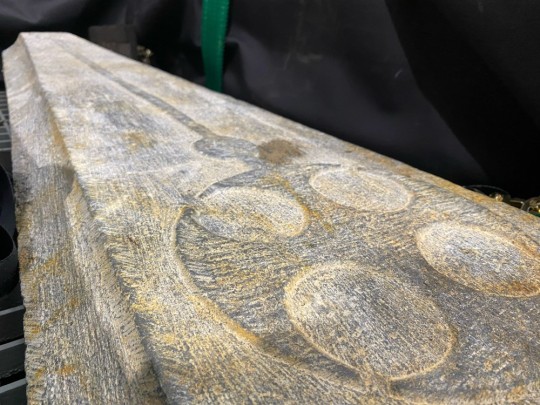
“Although Purbeck marble was quarried near Corfe Castle there has always been a debate about how much work was done here and how much was done in London. Now we know they were definitely carving them here, but they hadn’t been polished into the usual shiny finish at the time they sank so there is still more we can learn,” Tom said.
The team will continue to explore and protect the wreck over the coming years which they hope will include an operation to record the timber frames of the ships hull which are still well preserved in the sand. Tom is also planning to use this as a training opportunity for his students at the university.
“The future aim of the project is to train the next generation so that they get the same opportunities I had. We’ve already started teaching our second-year students to dive and as they get into the third year we’re going to take them out to sea and teach them their first steps to becoming maritime archaeologists,” he said.


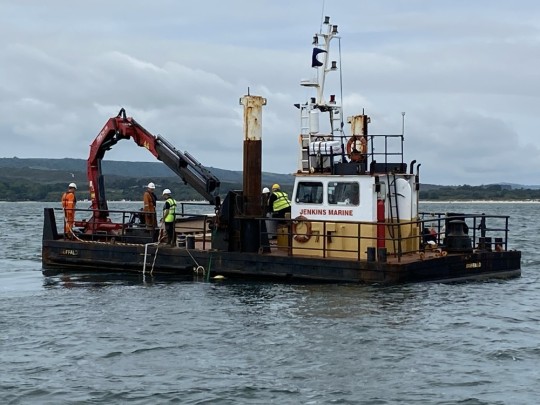
#Medieval Grave Slabs Recovered From Historic Shipwreck#Dorset coast#Mortar Wreck#Purbeck marble#Henry III#Maritime archaeologists#archeology#archeolgst#history#history news#shipwreck
51 notes
·
View notes
Text






The Princess of Wales's official appearances in 2024.
•Trooping the Colour on June 15th 2024, at Horse Guards Parade in London, England.
•Day fourteen of the Wimbledon Tennis Championships on July 14th 2024 at the All England Lawn Tennis and Croquet Club in London, England.
•Message at the end of the Olympic Games 2024 and congratulating Team Great Britain on August 11th 2024, at Anmer Hall in Norfolk, England.
•Video filmed during the summer holidays in August 2024, in which The Princess of Wales announced she finished her preventive chemotherapy treatment, in Norfolk, England.
•Meeting privately with photographer and cancer patient Liz Hatton, 16, on October 2nd 2024, at Windsor Castle in Windsor, England.
•Visiting Southport on October 10th 2024, to show support to the community and hear how local people have come together as the town recovers from the tragic knife attack that took place on July 29th 2024, in Southport, England.
•Royal British Legion Festival of Remembrance at the Royal Albert Hall on November 9th 2024 in London, England.
•National Service of Remembrance at The Cenotaph on November 10th 2024 in London, England.
•Ceremonial welcome for Their Highnesses The Amir Sheikh Tamim bin Hamad Al Thani and Sheikha Jawaher of Qatar on December 3rd 2024, at Horse Guards Parade in London, England.
•"Together at Christmas" Carol Service on December 6th 2024, at Westminster Abbey in London, England.
•Christmas Morning Service on December 25th 2024, at St Mary Magdalene's Church in King's Lynn, England.
📷 (3, 4, 5, 6 & 7) : Kensington Palace, Will Warr & Andrew Parsons/Kensington Palace.
#british royal family#england#2024#june 2024#trooping the colour#trooping the colour 2024#wimbledon#wimbledon 2024#july 2024#august 2024#olympic games#olympic games 2024#september 2024#october 2024#liz hatton#southport#november 2024#festival of remembrance#festival of remembrance 2024#remembrance day#december 2024#qatar state visit#together at christmas 2024#christmas#christmas 2024#princess of wales#princess of wales's official appearances 2024#the wales#my edit
16 notes
·
View notes
Text
Probably a clue to the cult that kidnapped the twins
Ok, this is my first post here and I don't know much about English so I'll use the translator.I hope that a part of kurofandom can see this and tell me what they think.
A few days ago I started rereading the twin reveal arc manga, and since lately I've been doing research on gothic/medieval architecture, I saw this panel from chapter 135 and thought "this castle seems to be medieval".
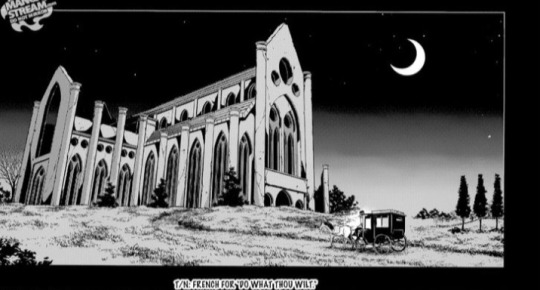
then the idea of looking for information on satanic sects during the Victorian era occurred to me, and although in reality there was very little information about it, after searching for a while I finally found a page that told me about what I was looking for.

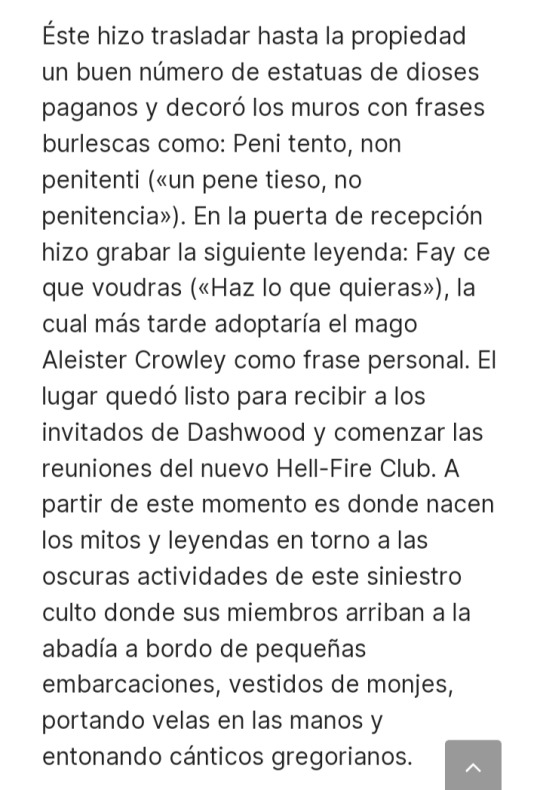



Well this information is about a man named Sir Francis Dashwood, like many of the young people of Victorian England who prided themselves on being part of blue blood families, he was an inexhaustible traveler. He toured almost all of Europe as part of his training, but he always expressed a very marked passion for Italy. Dashwood was a man of the world, surrounded by powerful friends in politics, banking and the art world. He held important positions in the civil service of England. He was also a notable lover of parties, music, food, drink and women in large quantities, in addition to art and Greco-Roman cultures. Quite a character with notable influences that he had access to practically what he wanted. He lived near the River Thames, in Buckinghamshire, in a huge mansion in West Wycombe, surrounded by luxuries and servants who fulfilled any mandate 24 hours a day. In it he held meetings with notable friends of his and members of Masonic lodges in which his vices surfaced permanently.
However, he had in mind the creation of a select secret group in which he could discuss freely about political and philosophical issues exclusively, made up of elegant and influential gentlemen from English high society. This is how he found the ideal place to carry out these meetings: Medmenham Abbey, whose owners were members of the Duffield family, and which was about five kilometers away from his mansion. The Duffields agreed to rent the property, erected around 1200 by a congregation of Cistercian monks. The place was perfect in every way: away from prying eyes and with an atmosphere of mysticism, thanks to its medieval air that enchanted Sir Francis.
He had a good number of statues of pagan gods moved to the property and decorated the walls with mocking phrases such as: Peni tento, non penitenti ("a stiff penis, no penance"). On the reception door he had the following legend engraved: Fay ce que voudras (<< Do what you want »), which would later be adopted by the magician Aleister Crowley as his personal phrase. The place was ready to receive Dashwood's guests and start the meetings of the new Hell-Fire Club. From this moment is where the myths and legends are born around the dark activities of this sinister cult where its members arrive at the abbey aboard small boats, dressed as monks, carrying candles in their hands and singing Gregorian chants.
It should be clarified that in reality the cult called themselves "The Monks of Medmenham". The name "Hell-Fire" club was more of a derogatory nickname.
So reading all this information I realized something, the phrase that this cult used was "fray ce que voudras" which means "Do what you want" or "Do your will" and this same phrase is used by the members of the cult that kidnapped to the twins.
In this part of chapter 135.

here I realized that when they arrive at that castle the receptionist asks "are you a monk?" To which the other responds with "Fay ce que voudras" (Do what you want). The same phrase used by members of the cult The Monks of Medmenham.
So I would assume that this is a hint that Yana left us and I don't see anyone else talking about it. I don't know if so many people from kurofandom follow me but tell me what you think about this, we should investigate further but I think this is a very obvious clue.
253 notes
·
View notes
Text
The Great Houses of For King and Country
House Wynd
Title: Lord Paramount, Emperor Edmund Wynd
Ancestral Seat: Wyndham Castle
Region: The Wetlands
Coat of Arms: Partizan Spear with Grey Cloth tied to end
Motto: “Strike True, Strike Once”
Vassal Houses: Gray, Freymen, Cole, Dustin, Courtney, Cadfael, Douglas
House Radwell-Cadderly
Title: Lord Paramount Cade Radwell-Casterly
Ancestral Seat: Two Prince's Crossing
Region: The Princeland
Coat of Arms: Two Inverted Golden Crowns and a Golden Sun Between
Motto: “Only One Crown Above Ours”
Major Vassal Houses: Royce, Roy, Vardy, Barclay, Harvey, Godwell, Radwell, Carter, Cadderly
House Merivale*
Title: Lord of the Vale, Lord Paramount Lancet Merivale
Ancestral Seat: Kingsport
Region: The Vale and Great Lakes
Coat of Arms: Golden Crowned Falcon and Golden Buck on Split Green and Blue Background.
Motto: “Honor From On High”
Major Vassal Houses: Uplands, Greenspan, Flowers, Merivale-upon-the-Lake, Achillande, Lunete, Grenplace, Cessair
House Abbey
Title: Lord Paramount Finneen Abbey
Ancestral Seat: Oldchurch
Region: The Midlands
Coat of Arms: Silver Crown in White Star
Motto: “Steel to clean the hearts of men”
Major Vassal Houses: Morrel, Coffer, Abney, Woods, Arden
House Chamer
Title: Warden of the Hinterland, Lord Paramount Ornold Chamer
Ancestral Seat: Mount Reave
Region: The Hinterlands and Firth
Coat of Arms: Bucking Horse
Motto: “All things can be ordered”
Major Vassal Houses: Cramer, MacAffey, Mulholland, Vicar
House Champion
Title: Warden of the Greater Realm, Lord Paramount Hal Champion
Ancestral Seat: Guard's Round Hall
Region: The Borderlands
Coat of Arms: Knight in a Field of Wheat
Motto: “Faithful Unto Death”
Major Vassal Houses: Daunt, Gallant, Richard, Radclyffe, Reeds
House Fischer
Title: Stewardess of the Royal Woods, Lady Paramount Moira Fischer
Ancestral Seat: Diver Castle
Region: The Greenwood
Coat of Arms: Wooden Keep
Motto: “Swift to sow! Swift to swords!”
Major Vassal Houses: Keats, Trent, Pole, Diver, Greenwood, Hart
House Parish
Title: Lord-Governor of the Plain, Lord Paramount Merritt Parish
Ancestral Seat: Fortress Merill
Region: The Plains
Coat of Arms: Burning fortress flanked by rivers
Motto: "First to Fury"
Major Vassal Houses: Murgatroyd, Everly, Eccleston, Farnham, Gladwyn, Dane, Dwerry
House Galagar
Title: Lord Paramount, King o' the Rock Brent Galagar
Ancestral Seat: The Rook
Region: The Highlands
Coat of Arms: Heraldic Eagle flanked by Lions
Motto: “In Our Own Right, Kings”
Major Vassal Houses: Aron, Link, Broeker, Burnes, Arrowsmith, Keeper, Fletcher
*You are an heir of House Merivale up in the Vale and Great Lakes.
23 notes
·
View notes
Text
A note for readers of Wildfell Weekly (as well as others): the book that Gilbert buys for Helen Graham, Marmion by Sir Walter Scott, appears to have been extremely popular in its time; it is mentioned by characters in several other famous novels of the 1800s.
St. John Rivers buys it for Jane in Jane Eyre:
“I have brought you a book for evening solace,” and he laid on the table a new publication—a poem: one of those genuine productions so often vouchsafed to the fortunate public of those days—the golden age of modern literature. Alas! the readers of our era are less favoured.”
…While I was eagerly glancing at the bright pages of “Marmion” (for “Marmion” it was)…
…I had closed my shutter, laid a mat to the door to prevent the snow from blowing in under it, trimmed my fire, and after sitting nearly an hour on the hearth listening to the muffled fury of the tempest, I lit a candle, took down “Marmion,” and beginning—
“Day set on Norham’s castled steep,
And Tweed’s fair river broad and deep,
And Cheviot’s mountains lone;
The massive towers, the donjon keep,
The flanking walls that round them sweep,
In yellow lustre shone”—
I soon forgot storm in music.
It is also mentioned by Mina in Dracula (though she, or Stoker, makes a small error - the scene mentioned involves characters from Whitby Abbey, but occurs in Lindisfarne, a tidal island that was also, long ago, the home of the illuminated Lindisfarne Gospels):
Right over the town is the ruin of Whitby Abbey, which was sacked by the Danes, and which is the scene of part of “Marmion,” where the girl was built up in the wall.
The book is a poetic epic set at the time of the Battle of Flodden Field (1513); I like the poetry a great deal, and the plot is nicely dramatic and Romantic, despite values dissonance (I do not find the title character as sympathetic as Scott does).
All this is to say - would people be interested in reading this story beloved by so many of our favourite characters? I could put it together as a Substack newsletter and email it out a little a day (probably for a few months total) starting in the new year. It’s not long (about 150 pages), it’s a good read with excellent poetic cadences and lots of high drama and imagery, and it gives a sense of what was popular among people who enjoyed the Gothic and Romantic.
#wildfell weekly#jane eyre#dracula#dracula daily#mina murray#the tenant of wildfell hall#marmion#sir walter scott
58 notes
·
View notes
Text
"There are indications that [King William the Lion of Scotland] relied on Queen Ermengarde and allowed her to play an increasingly influential part in public affairs. A resentful Glasgow canon was to allege that in 1207 Walter, a royal chaplain, obtained the position of bishop of Glasgow after bribing not only the King’s chamberlain but the Queen herself. There are signs that her relatives also profited from their relationship with her: Richard de Beaumont, possibly a brother or nephew, acquired a sizeable estate in the Crail area. Ermengarde appears to have acted as mediator when William was negotiating with King John of England in 1209, and she certainly did so with great aplomb when her husband met John at Durham in February 1212. According to Bower, she showed herself in their discussions to be ‘an extraordinary woman, gifted with a charming and witty eloquence’. As a result of her efforts, the peace between the two countries was renewed, and it was agreed that her son Prince Alexander should be given an English wife.
That same summer, William fell ill, and there are signs that Ermengarde exercised considerable influence during his sickness. The King was nearly seventy by now, and although he recovered, his health remained poor. He was well enough to travel as far north as Elgin in the summer of 1214, but the lengthy journey brought on some sort of collapse and he was taken south again to Stirling by very easy stages. Ermengarde was probably with him when he saw his lords for the last time and urged them to accept his sixteen-year-old son Alexander as king. He died in Stirling Castle at the beginning of December 1214.
Next morning, the prelates and nobles urged the Queen to supervise the arrangements for the funeral, but she was ‘in a state of extreme mourning and worn out with grief’. Try as they might, they could not rouse her from her sorrow and so they hastily took Prince Alexander to be crowned at Scone while Ermengarde remained with her husband’s body. William was then buried in his abbey of Arbroath. Ermengarde lived for another twenty years, devoting her considerable energies to raising money to found a Cistercian abbey at Balmerino in Fife. She purchased the necessary land for a thousand merks and oversaw the construction of the building, which was made of local red stone. Monks from Melrose settled at the abbey on St Lucy’s Day, 13 December 1229 and both Ermengarde and her son Alexander frequently stayed there. When Ermengarde died on 11 February 1233, she was buried before the high altar at Balmerino. It is a pity that the records do not tell us more about this effective and influential Queen Consort."
-Rosalind K. Marshall, Scottish Queens 1034-1714
#ermengarde de beaumont#scottish history#historicwomendaily#13th century#my post#william I of Scotland#william the lion#women in history
14 notes
·
View notes
Text




On November 22nd 1888 the Sword, reputed to be that of Sir William Wallace was taken to The National Wallace Monument, where it has been on display more or less ever since, but not without indecent!
It is believed that the Wallace Sword remained at Dumbarton Castle from 1305, when Wallace was imprisoned there after his capture. However, there is no record of the Sword’s whereabouts until 1505 when it was first mentioned in the Accounts of the Lord High Treasurer of Scotland ordered for its handle to be repaired. The Lord High Treasurer’s accounts for that year during the reign of James IV, shows that there was the entry: Item, ( for )
“bynding of ane riding sword, ane rappyer, and binding of Wallas sword with cordis of silk, new hilt and plommet.”
So when it was agreed that the sword would be taken to Abbey Craig the people of Dumbarton were none too pleased with this and let it be known……
“The Dumbarton Town Council feel aggrieved at the removal of Wallace’s sword from the castle to the Wallace Tower on Abbey Craig, and have resolved to remonstrate with the War Office authorities, and ask that the historic weapon be returned to the place where it has lain for between five and six hundred years.”
Charles Rodgers, a principle fundraiser for the Monument, had been trying to move the Sword to the Monument since its completion, but his request was refused by the Colonel of the Royal Artillery at Dumbarton Castle in 1875 and it wasn’t until 1888 that the War Office agreed to transfer of the sword.
The Wallace Sword has always stood for freedom, and is sometimes referred to as Freedom’s Sword. Wallace’s legacy has inspired audiences around the world. Wallace, and his sword, have become symbols used by individuals and groups to bring attention to their cause.
In 1912 suffragette Ethel Moorhead smashed the sword case in the National Wallace Monument to draw attention to the women’s cause for the freedom of political expression.
The Wallace Sword was stolen from The National Wallace Monument on the 8th November 1936 by Scottish Nationalists at Glasgow University, who later returned the sword after realising the distress the theft had caused.
The sword measures 5 feet 11 and 1/2 inches length; the blade varies in breadth from 2 1/4 inches at the guard to 3/4 of an inch at the point. The weight is six pounds, or three bags of sugar!
Historians cast doubt about the authenticity of the weapon, one points out that the person who owned it would have to be over 7 foot tall to use it, detailed analysis point to it being made up of several pieces from different centuries, none as early as the 13th century. Some say that the sword design is too modern for the time of Wallace. One historian, recognising the changes and the subtle details, has referred to this sword as the ‘ghost’ of William Wallace’s sword.
Whether the sword is genuine or not does not matter one jot to me, it is symbol of the Freedom that Wallace fought for during the first Wars of Scottish Independence.
There is a full account of the proceedings on November 22nd 1888 on the Clan Wallace web site here https://clanwallace.org/.../about.../the-wallace-sword/
37 notes
·
View notes
Text










Castle ruins Ter Elst in Duffel, Belgium.
The origins of Ter Elst castle ruins date back to the Middle Ages. So far known, the oldest reference to Ter Elst Castle can be found in a source written in the 12th century. In the 15th century it was expanded into a beautiful castle. High-ranking guests regularly stayed there, such as Margaret of York and Philip De Schone. From the 17th century it was used as a parsonage. In 1799 the castle was seized and sold by the French occupiers. More than seventy years later, the domain was given an industrial destination. A brickyard was active there until the First World War. After heavy damage in 1914, the castle ruins continued to deteriorate into ruins.
Initially the castle was owned by the Hildincshusen brothers. From 1356 until the French Revolution in 1789, the castle was owned by the Tongerlo Abbey and was occupied by the steward. It was also used as a residence for noble people. The castle burned down in 1584 after which it was rebuilt. A century later, around the end of the 16th century, it was a parsonage. According to 17th and 18th century drawings, Kasteel ter Elst was an extensive building, surrounded by moats and gardens. In 1799, the castle was sold to Louis Hermans, who had three of the four main buildings of the complex demolished and the wing section with the towers restored. After heavy damage in 1914, the castle ruins continued to deteriorate into ruins.
In 1972, the municipality of Duffel purchased the former castle grounds from the private owner. The local government almost immediately started a protection procedure and a renovation plan. In September 1982, the restored castle ruins and the redesigned park area opened to the public. Currently new restorations have been initiated.
#ruins#architecture#europe#historic buildings#historical#belgium#history#flanders#belgica#belgie#belgique#duffel#mystic ruins#goth aesthetic#gothic elegance#moody aesthetic#autumn#autumn aesthetic#autumn atmosphere#autumnal#fall vibes#sunset#twilight#castle#chateau#halloween#chateaux#kasteel#herfst#moon
14 notes
·
View notes
Text











For my next Monster AU art, here's the Snack Pack in their monster looks. Composed of DJ Suki, Cooper, Smidge, Biggie, Guy Diamond, Satin and Chenille, Legsly, Fuzzbert, and Prince Darnell, they are one of the pack of friends that Poppy, Branch, and Rose would lead in their fright-outs whenever they give humans nightmares by eating or scaring them out of their socks. I put them in their hard rock outfits or disguises and add some monstrous details to it.
The first founding members of the team, DJ Suki, Cooper, Smidge, Biggie, Guy Diamond, Satin and Chenille, and Fuzzbert are the first to become friends with Poppy and Rose, later Branch. They first met the two close beast friends when they and several monsters sought shelter in Nevermore Castle and the territories near it after running away from a monster hunter, who turned out to be Chef. As they grow up with the two monstresses, they soon form the Snack Pack, with Branch later joining them. Legsly is the only one to be added after Rose raised her from the grave while Darnell later joined the group at chapter 3.
DJ Suki is a banshee, so she can fly and float, hear things outside the range of normal perception, solid to intangibility shifting and vice versa, precogniciton, and her signature banshee scream, which she shares with her aunts and her niece, CJ Suki.
Cooper and Darnell are plant monsters, since their parents are also plant monsters, with Essence being born from a seed of a corpse flower and Quincy is born from a seed of a monster tree, making them based on different plants. Like their parents, the funky plant brothers can control vegetation, communicate with plants, and create pollen out of their mouths or their vine hairs to control anyone but they can control one individual at a time. After escaping from the monster hunter, the twins and their parents stayed with Celestia, Rose and the Nevermore Clan until they were given an abandoned mansion as their own home.
Smidge is a transgender goblin with super strength, despite her size. As a member of the Pukwudgie clan, Smidge is trained among her tribe to become a warrior but things went south when they were attacked by the same monster hunter and she and her family escaped to Nevermore Castle with the other monsters. There, she met Rose and Poppy, who later befriended her and soon, she used her superhuman strength to good use on the humans.
Biggie, on the other hand is a type of monster called a Hyde, which is a monster that transform into their beast form with long claws, fanged teeth, and immense strength, mobility, and resilience, but he is able to transform properly like his older brother, who he only had after their parents were killed by the same monster hunter that killed the other Snack Pack members’ parents. He is always accompanied by his pet ectoplasmic goo dog, Mr. Dinkles and he only transforms when he needs to protect his friends from monster hunters and hordes of angry humans.
Since I HC Guy Diamond as South Asian, he would be a yeti, like Abbey Bominable in Monster High. He and his family migrated from the snowy mountains of Mount Everest to their new home but the parents were killed by the same monster hunter, leaving their daughters and Guy, who hasn't got the transition yet, to escape and find refuge in Nevermore Castle, where he met Rose and Poppy. Years after transitioning to male, Guy Diamond felt more confident in himself that he becomes the life of the party and the resident drama king. He had a lot of boyfriends and male lovers until he got pregnant after a one-night stand with a male yeti and had baby Tiny. Like all yetis, he has cryokinesis, superhuman strength, and has the ability to shift his size. Tiny, who is just a baby yeti, is still learning how to use his powers so it would be unpredictable
Since Satin and Chenille are Japanese in my human Au, they'd be the jorōgumo in my monster Au. The twins, alongside Fuzzbert are immigrants from Japan but they lost their parents because of a monster hunter, which caused them to seek refuge with Rose’s vampire clan. Having a venomous bite, three arms, an endless supply of silk threads, and the ability to crawl on walls and ceiling is extremely useful for the two. They can weave fabrics, sew and make clothes and multitask while at the same time, catch their prey.
Fuzzbert is a werecat who is the silent member of the group, due to a medical condition that rendered him mute. He lost his parents because of the same monster hunter and ended up living in the Nevermore Castle. Despite not being able to speak, he is a skilled climber and hunter, due to his cat physiology and superhuman condition.
Legsly, on the other hand, is a zombie in the monster Au. She became a new member of the Snack Pack after she was raised from the ground by Rose, who was practicing vampiric magic. Unlike all zombies, she retained sapience after the transformation but she can still absorb memories and gain skills and abilities through eating the brains of humans.
Here’s an alternate Biggie pic with his pet Mr. Dinkles as an ectoplasmic goo Pomeranian.

There's more to come so stay tuned, ghouls and mansters!
#dreamworks trolls#trolls the beat goes on#trolls world tour#trolls trollstopia#trolls band together#the snack pack#dj suki#cooper#smidge#biggie#mr. dinkles#guy diamond#satin and chenille#legsly#prince d#darnell#fuzzbert#banshee#plant monster#goblin#hyde#jorogumo#arthropodian#zombie#werecat#monster au#shocktober2024
16 notes
·
View notes
Photo

Diversity in Church Architecture in Medieval England
Medieval English churches differed in size and layout. Their original and evolving role(s), financial and material resources, and architectural fashions helped determine variability. However, their look ultimately grew from a constant symbiosis between being a place for worship and practical matters. During the 10th-15th centuries, stone construction became firmly established, and that witnessed a golden era of church building.
Purpose & Resources
Immediate, mundane reasons for diversity were just as for any other buildings – houses, castles, offices – it depended on the purpose for which they were originally built and the financial and material resources available to the initial builders and to later owners who wanted to extend and/or beautify it.
Impoverished communities created basic churches employing the means and materials members of the settlement possessed or could source nearby using their own sweat and skills. Rich sponsors had the wherewithal to envisage and execute the most lavish projects money and authority could buy, transporting materials from far and wide, engaging the leading designers, technology, masons, metalworkers, carpenters, painters, and glaziers of the day.
Basic buildings might be erected as outposts of mother churches/minsters or by individual villages or minor landowners wanting a place, however humble, to express their faith, as a centre for the daily, weekly, and yearly cycles of devotion that dominated and led peoples' lives. They were simple rectangular structures, large enough for maybe 15 to 20 worshippers. The grandest undertakings were sponsored by major royal, aristocratic, or religious order benefactors to produce leading centres of ecclesiastical, administrative, and scholarly influence. Many of the great cathedrals, abbeys, and minsters, like Durham, Lincoln, and Old St Paul's London were wonders of the world at the time they were built, well over 100 meters long, 100 meters high, or more, and tens of meters wide.
Of course, the majority of churches fell in between these extremes. Some might not initially have been conceived on a grand scale, yet over the centuries they grew as patrons and communities responded to changing population sizes and advances in building technology that fed the desire to always have the bigger, better, more beautiful, the latest architectural fashion. In the economic climate of the later Middle Ages, fresh sponsors of church building and extension entered the scene. Newly rich guilds and merchants in many towns employed their wealth to craft ornate chapels or enhance an existing church with which they were associated. From unpretentious origins, many modest buildings thus grew into impressive houses of God – witness Leicestershire's grandest church in Melton Mowbray backed by wool traders' money, and the great wool churches of Norfolk and Suffolk.
Continue reading...
30 notes
·
View notes